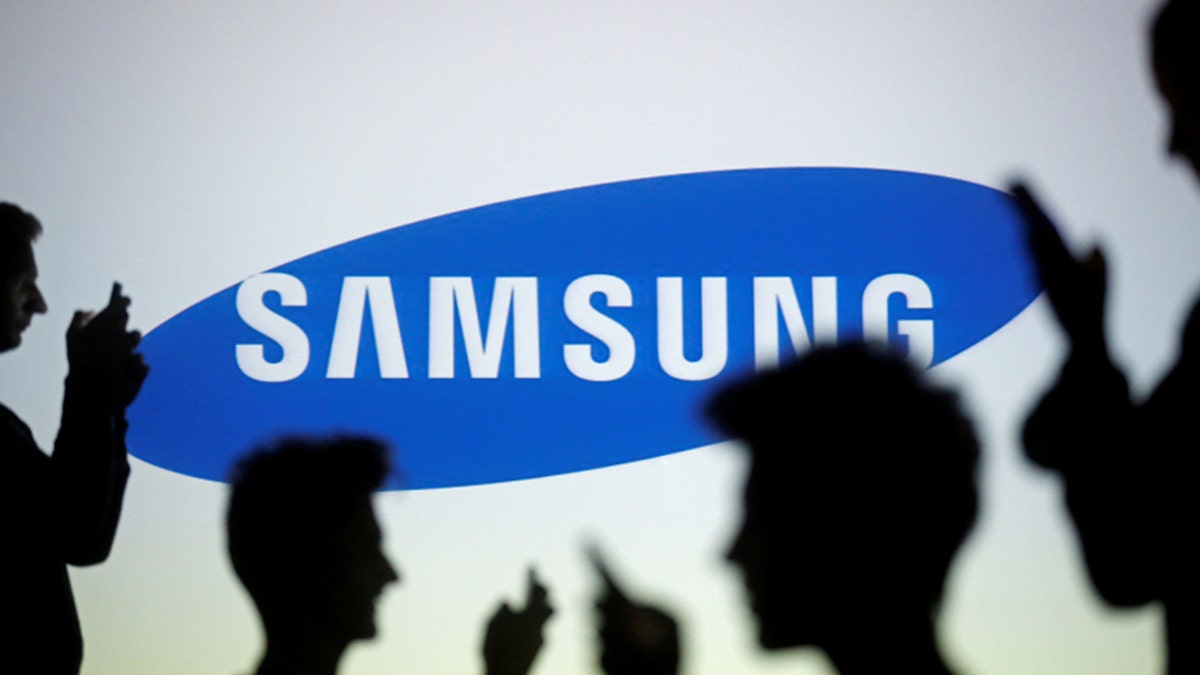
People are silhouetted as they pose with mobile devices in front of a screen projected with a Samsung logo, in this picture illustration taken in Zenica October 29, 2014. (REUTERS/Dado Ruvic/Illustration/File Photo)
Samsung is getting ready to tee up its next flagship Galaxy smartphone against a backdrop of growing rumors about rival Apple’s 2017 iPhone.
Expected to be announced by the end of March, the next-gen Samsung Galaxy S8 models will sport bigger displays than current models -- 5.8 inches and 6.2 inches respectively, according to recent reports, most notably in the Guardian and Venture Beat.
Samsung, for the first time, may also standardize on curved organic light-emitting diode (OLED) “dual-edge” displays. To date, the mainstream Galaxy models have not had a curved display. For example, the Galaxy S7 (5.1 inches) does not have a curved display, while the pricier S7 Edge (5.5 inches) does. A display with curved edges provides more display area without increasing the overall size of the phone.
One neat trick that Samsung is expected to pull off with the S8 is covering the front of the phone with more display area by shrinking the bezels, or display borders, on the top and bottom of the phone, as affiliate Samsung Display has hinted at in recent videos. Samsung is also expected to adjust the aspect ratio (the ratio of the width to the height of the screen) of the display. Both of these developments will allow Samsung to minimize an increase in the overall size of the phone.
APPLE'S IPHONE 'X' MIGHT COST AS MUCH AS A MACBOOK
Other highlights, as pointed out by Evan Blass at Venture Beat, are new processors that boost overall performance by 11 percent while also being more energy efficient.
“That improved power consumption will be critical, because despite the vastly increased display sizes, battery capacity is said to be a relatively conservative…for the 5.8-inch and 6.2-inch designs, respectively,” Blass wrote.
And a rumored standard feature that will undoubtedly please consumers is the 64GB of baseline storage – up from 32GB on the Galaxy S7. The option for an additional 256GB microSD card will remain.
Other reported specs include a USB-C port for charging, a 3.5mm headphone jack (which Apple dropped on the iPhone 7), a 12-megapixel rear camera and front-facing 8-megapixel selfie camera.
WHAT TO EXPECT WITH APPLE'S 2017 IPHONE 'X'
Samsung is also rumored to ditch the physical home button in favor of software buttons. And the fingerprint sensor will be on the back of the phone. Note that neither of these latter rumored changes would be groundbreaking. The Google Pixel, for example, has no physical home button and has the fingerprint sensor on the back.
And the price? Blass expects both models to be pricier than the Galaxy S7 and S7 Edge. Possibly $100 more. Both are expected to go on sale April 21.
OLED iPhone 8/X will follow Galaxy S8
Samsung and Apple are locked in a tight market share battle. This week market researcher Gartner said Apple shipped more phones in the fourth quarter than Samsung, the first time since the fourth quarter of 2014.
And reports about the Galaxy S8 are vying with a flurry of new reports about Apple’s upcoming iPhone 8 (or iPhone X as some on Wall Street are calling it), due later this year.
APPLE WATCH SALES SPIKED OVER THE HOLIDAY: SMARTWATCHES ARE HERE TO STAY
MacRumors cited an analyst report this week that said the OLED iPhone 8 will feature a 5.8-inch display “with 5.15 inches of usable screen space.” While the iPhone 8’s display is expected to take up the entire front of the phone, a portion of that space will be devoted to “virtual buttons.”
The overall physical size of the phone is said to be similar to the 4.7-inch iPhone 7, which would allow for easier one-handed operation.
“Such a size is possible with a 5.8-inch [display] panel because there will be no extra space outside of the display,” MacRumors said, referring to the elimination of bezels.
Apple is also expected to increase battery capacity -- without increasing the size of the phone -- by adopting an advanced stacked circuit board.
Samsung and Apple did not respond to a request for comment from Fox News.
